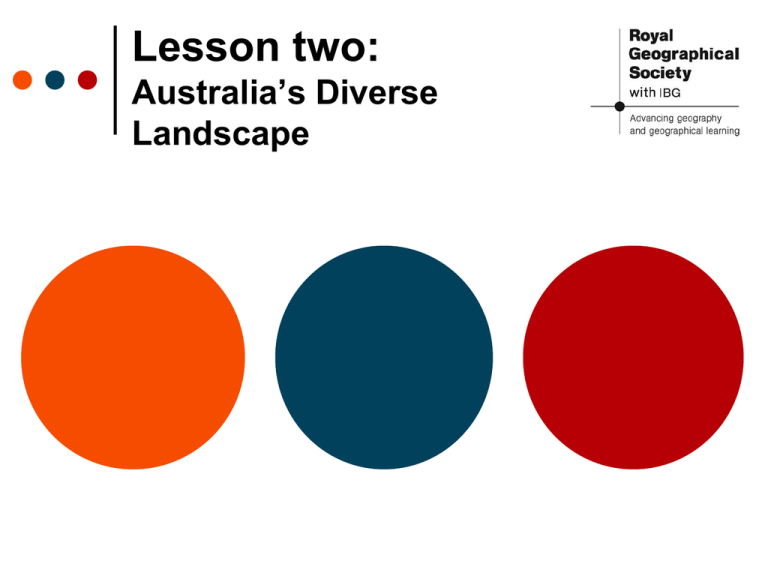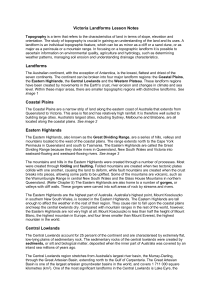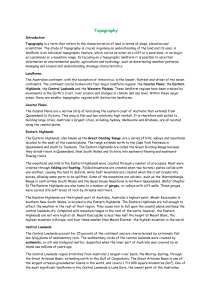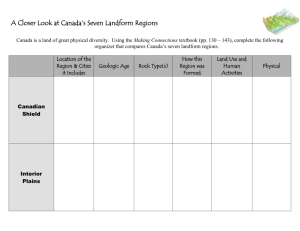Australia's Diverse Landscape
advertisement

Lesson two: Australia’s Diverse Landscape Australia is an island An island is a land mass surrounded by water. Which oceans and seas surround Australia? Source: http://imglayer.net/map-of-australia-3/ Diverse landscape Mountains Rural areas Coasts Deserts Urban areas: coast al cities Lakes and rivers Small towns and villages in inland areas Diverse landscape Physical features The Australian continent is low, flat and dry compared with other continents of the world. It can be divided into four major landform regions: the Coastal Plains, the Eastern Highlands, the Central Lowlands and the Western Plateau. These landform regions have been created by movements in the Earth's crust, river erosion and changes in climate and sea level. Map of landforms Key questions to consider: Which landform region covers the largest area of Australia? Which landform region do you think is the lowest? Which is the highest? Tasmania is the small island to the south of the mainland, which landform region is Tasmania in? Western Plateau The Western Plateau covers about one third of the continent. The word ‘plateau’ means flat area of raised landscape. This region of dry land includes ancient rocks, some over 3.6 billion years old. The region is relatively flat due to erosion, which has affected the area for millions of years. There are also some mountain ranges on the Western Plateau found in areas with erosion-resistant rocks. 70% of the Western Plateau is desert, and there are also salt lakes. Free-standing rocks The Western Plateau has free-standing rocks, including Uluru or Ayers Rock: a large sandstone rock formation. It is 346m high and has a circumference of 8km. It has great cultural significance to indigenous Aboriginal Australians. Ayers Rock Tour Continued © Peter Edgeler, Flickr Central Lowlands The Central Lowlands cover 25% of Australia and are very flat, low-lying plains of sedimentary rock. Lake Eyre, the lowest point of the Australian continent, is 15 metres below sea level and spreads over almost 10 000 square kilometres. The Central Lowlands receive the least amount of rain a year out of all the regions and contain large deserts. Wikipedia Commons The Simpson Desert has 30-metre high red sand dunes for hundreds of kilometres. Simpson Desert Scrub © John Benwell, Flickr Eastern Highlands: The Great Dividing Range This region of hills, valleys and mountains located to the west of the coastal plains. The Eastern Highlands are called the Great Dividing Range because they divide rivers in Queensland, New South Wales and Victoria into eastward-flowing and westward-flowing rivers. The Eastern Highlands are tall enough to affect the climate in the rest of their region. They cause rain to fall upon the coastal plains and keep the central lowlands dry. Eastern Highlands Some of the mountains are volcanic. The Eastern Highlands are also home to gorges (valleys with cliff walls). These gorges were carved into soft areas of rock by streams and rivers. Weano Gorge© Graeme Churchard. Flickr Highlands in Australia Australia's highest point is Mount Kosciuszko in southern New South Wales, is located in the Eastern Highlands or Great Dividing Range. Compared with mountain ranges in the rest of the world, the Eastern Highlands are not very high at all. At 2228 metres high, Mount Kosciuszko is less than half the height of Mount Blanc, the highest mountain in Europe, and four times smaller than Mount Everest, the highest mountain in the world. The top 10 highest mountains in Australia The Coastal Plains A narrow strip of land along the eastern coast of Australia. This area is flat and has relatively high rainfall. Australia's largest cities are all located along the coastal plains. http://upload.wikimedia.org/wikipedia/commons/d/de/Australian_PR_COB_2006.PNG Main Activity Use the overlay maps on your handout to answer the questions about Australia’s physical geographical features, regions and landforms. Plenary: Famous landscapes Plenary Feedback your answers to the questions. Would you like to visit Australia? Which landform region would you like to visit most and why? Consider how Australia’s diverse natural environment might be threatened and how it can be protected in the future using the next slide. Delicate landscapes: Human activity affects the physical environment Kakadu National Park in the Northern Territory suffers from invasive species and toxicity from mining. The Great Barrier Reef has also suffered damage from discharge from mining nearby. Kakadu National Park © Jeremy Foster ,Flickr Great Barrier Reef, Australia © eutrophication&hypoxia,Flickr







